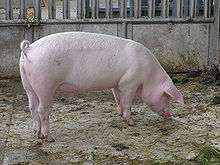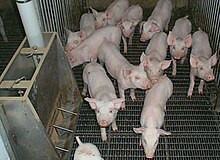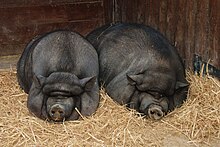Pig
This article needs additional citations for verification. (September 2007) |
This animal-related article may require cleanup to conform to a higher standard of quality. |
| Domestic Pig | |
|---|---|

| |
| A domestic pig on an organic farm in Solothurn, Switzerland | |
Domesticated
| |
| Scientific classification | |
| Kingdom: | |
| Phylum: | |
| Class: | |
| Order: | |
| Family: | |
| Genus: | |
| Species: | |
| Subspecies: | S. s. domestica
|
| Trinomial name | |
| Sus scrofa domestica Linnaeus, 1758
| |
| Synonyms | |
|
| |
The domestic pig, known in some areas as the hog, is a domesticated livestock animal, farmed for meat (pork, bacon, ham, sausages etc). Most domestic pigs have rather sparse hair covering on their skin, although woolly coated breeds are known (Mangalitsa pig), and some were popular in the past.[1]
The domestic pig is most often treated as a subspecies of its wild ancestor, the wild boar, and in this case it is given the scientific name Sus scrofa domesticus.[citation needed] Some taxonomists treat the domestic pig as a separate species, when it is called Sus domesticus, and wild boar is S. scrofa.[2] Wild boar were in human association as early as 13,000–12,700 BP. Escaped domestic pigs have become feral in many parts of the world (for example, New Zealand) and have caused substantial environmental damage.[3][4]
Origins
Archeological evidence suggests that pigs were domesticated from wild boar as early as 13,000–12,700 BP in the Near East in the Tigris Basin[5] being managed in the wild in a way similar to the way they are managed by some modern New Guineans.[6] Remains of pigs have been dated to earlier than 11,400 BP in Cyprus that must have been introduced from the mainland which suggests domestication in the adjacent mainland by then.[7] There was also a separate domestication in China.[8].
DNA evidence from sub-fossil remains of teeth and jawbones of Neolithic pigs in Europe shows that the first domestic pigs there had been brought from the Near East. This stimulated the domestication of local European wild boar resulting in a third domestication event with the Near Eastern genes ceasing in European pig stock. Modern domesticated pigs have involved complex exchanges with European domesticated lines being exported in turn to the ancient Near East[9][10]. Historical records indicate that Asian pigs were introduced into Europe during the 18th and early 19th centuries.[8]
The adaptable nature and omnivorous diet of the wild boar allowed early humans to domesticate it readily. Pigs were mostly used for food, but early civilizations also used the pigs' hides for shields, bones for tools and weapons, and bristles for brushes.[11] Pigs were brought to southeastern North America from Europe by de Soto and other early Spanish explorers. Escaped pigs became feral and caused a great deal of disruption to Native Americans cultures who had no domesticated livestock.[12]
Food




The domestic pig is used for its meat, called pork. Other products made from pigs include sausage, bacon, gammon, ham and pork scratchings. The head of a pig can be used to make a preserved jelly called head cheese (brawn). Liver, chitterlings, blood (blood pudding or black pudding) and other offal from pigs are also widely used for food. In some religions, such as Judaism and Islam, there are religious restrictions on the consumption of pork.
Farming
In developing nations, and often in developed nations, the domestic pig is raised outdoors in yards or fields. In some cases pigs are allowed to forage in woods, where they may be watched by swineherds, the equivalent of shepherds for pigs. In industrialized nations, domestic pig farming has shifted away from the traditional pig farm to large-scale intensive pig farms where meat can be mass-produced. This has resulted in lower production costs, but more significant animal welfare concerns.
Individual farm management practices focus on, among other things, housing facilities, feeding and ventilation systems, and temperature and environmental controls. Just as producers have to determine the type of facilities and equipment for their farm, they must find the practices that best fit their farm’s specific situation. Some procedures and treatments can be short-term stressors, so producers must weigh the long-term welfare, health and management benefits to the animals.
Using the knowledge obtained from scientific study, some producers have adopted and adapted techniques and husbandry skills to protect the welfare of their animals. They feel a personal and moral responsibility to take care of their animals and ensure that the animals are safe, but they also must earn a profit from their business. They consider anything short of providing the best, humane care possible as being self-defeating.
Uses in truffle hunting
The domestic pig is also widely used in France and other countries to search for truffles. This is because the truffle smells similar to the pheromones of the animal.[citation needed]
As pets
Pigs are known to be intelligent animals and can be trained similarly to dogs, though they may excel in different tasks.[13] Asian pot-bellied pigs, a small type of domestic pig, have made popular house pets in the United States beginning in the latter half of the 20th century. Regular domestic farmyard pigs have also been known to be kept indoors, but due to their large size and destructive tendencies, they typically need to be moved into an outdoor pen as they grow older. Most pigs have a fear of being picked up, but will usually calm down once placed back on the floor. Pigs are rarely used as working animals. An exception is the use of truffle pigs – ordinary pigs trained to find truffles.
[14] Miniature pigs, or 'teacup pigs, which are specifically bred to be small (from 29-65 lbs) gained in popularity in Fall of 2009 after several mainstream press articles claimed they were a [15] popular pet to celebrities such as Rupert Grint of Harry Potter fame.
Breeds of pigs
Pigs are exhibited at agricultural shows, judged either as stud stock compared to the standard features of each breed, or in commercial classes where the animals are judged primarily on their suitability for slaughter to provide premium meat.
According to the American Livestock Breeds Conservancy [16], seven breeds of swine in the U.S. are critically rare (having a global population of fewer than 2000). Outside the U.S., the Auckland Island Pig (New Zealand) and woolly-coated grazing pig (Danube area) are known to be critically rare.
Pig farming terminology
Types of animal
| Global pig stock | |
|---|---|
| in 2007 | |
| Number in millions | |
| 1. | 425.6 (46.35%) |
| 2. | 61.7 (6.72%) |
| 3. | 35.9 (3.91%) |
| 4. | 27.1 (2.95%) |
| 5. | 26.6 (2.9%) |
| 6. | 26.1 (2.84%) |
| 7. | 18.1 (1.97%) |
| 8. | 15.9 (1.73%) |
| 9. | 15.5 (1.69%) |
| 10. | 14.9 (1.62%) |
| World total | 918.3 |
| Source: UN Food and Agriculture Organization | |
- Pig hog or swine, the species as a whole, or any member of it. The singular of "swine" is the same as the plural.
- Shoat, piglet or (where the species is called "hog") pig, unweaned young pig, or any immature pig.
- Sucker, a pig between birth and weaning.
- Runt, an unusually small and weak piglet, often one in a litter.
- Boar or hog, male pig of breeding age.
- Barrow, male pig castrated before puberty.
- Stag, male pig castrated later in life, (that is, an older boar after castration).
- Gilt, young female not yet mated, or not yet farrowed, or after only one litter (depending on local usage).[17]
- Sow, breeding female, or female after first or second litter.
Pigs for slaughter
- Suckling pig, a piglet slaughtered for meat.
- Feeder pig, a weaned gilt or barrow weighing between 18 kg (40 lb) and 37 kg (82 lb) at 6 to 8 weeks of age that is sold to be finished for slaughter.
- Porker, market pig between 30 kg (66 lb) and about 54 kg (119 lb) dressed weight.
- Baconer, a market pig between 65 kg (143 lb) and 80 kg (180 lb) dressed weight. The maximum weight can vary between processors.
- Grower, a pig between weaning and sale or transfer to the breeding herd, sold for slaughter or killed for rations[clarification needed].
- Finisher, a grower pig over 70 kg (150 lb) liveweight.
- Butcher hog, a pig of approximately 100 kg (220 lb), ready for the market.
- Backfatter, cull breeding pig sold for meat; usually refers specifically to a cull sow, but is sometimes used in reference to boars.
Groups
- Herd, a group of pigs, or all the pigs on a farm or in a region.
- Sounder, a small group of pigs (or wild boar) foraging in woodland.
Pig parts

- Trotters, the feet of pigs (they have four hoofed toes, walking mainly on the larger central two).
Biology
- In pig, pregnant.
- Farrowing, giving birth.
- Hogging, a sow when on heat (during oestrus).
Housing
- Sty, a small pig-house, usually with an outdoor run.
- Pig-shed, a larger pig-house.
- Ark, a low field-shelter for pigs (or other animals such as rabbits or chickens).
- Curtain-barn, a long, open building with curtains on the long sides of the barn. This increases ventilation on hot, humid summmer days.
See also
- ECODIPTERA
- Exotic pet
- Extensive farming
- Factory farming
- Intensive farming
- Intensive pig farming
- Taboo meat
Notes
- ^ http://www.malverngazette.co.uk/mostpopular.var.1476623.mostviewed.royal_visit_delights_at_the_three_counties_show.php Royal visit delights at the Three Counties Show.
- ^ Wilson, D. E.; Reeder, D. M., eds. (2005). Mammal Species of the World: A Taxonomic and Geographic Reference (3rd ed.). Johns Hopkins University Press. ISBN 978-0-8018-8221-0. OCLC 62265494.
- ^ http://query.nytimes.com/gst/fullpage.html?res=9E0CEED6103CF93AA15751C1A964958260&sec=&spon=&pagewanted=all Alien Species Threaten Hawaii's Environment.
- ^ http://www.nzetc.org/tm/scholarly/tei-Bio27Tuat02-t1-body-d1.html Introduced Birds and Mammals in New Zealand and Their Effect on the Environment.
- ^ *Sarah M. Nelson Ancestors for the Pigs. Pigs in prehistory. (1998)
- ^ Rosenberg M, Nesbitt R, Redding RW, Peasnall BL (1998). Hallan Cemi, pig husbandry, and post-Pleistocene adaptations along the Taurus-Zagros Arc (Turkey). Paleorient, 24(1):25–41.
- ^ Vigne JD, Zazzo A, Saliège JF, Poplin F, Guilaine J, Simmons A. (2009). Pre-Neolithic wild boar management and introduction to Cyprus more than 11,400 years ago. Proc Natl Acad Sci U S A. 106:16135–16138. PMID 19706455 doi:10.1073/pnas.0905015106
- ^ a b Giuffra E, Kijas JM, Amarger V, Carlborg O, Jeon JT, Andersson L. (200). The origin of the domestic pig: independent domestication and subsequent introgression. Genetics. 154(4):1785-91. PMID 10747069
- ^ BBC News, "Pig DNA reveals farming history" 4 September 2007. The report concerns an article in the journal PNAS
- ^ Larson G, Albarella U, Dobney K, Rowley-Conwy P, Schibler J, Tresset A, Vigne JD, Edwards CJ, Schlumbaum A, Dinu A, Balaçsescu A, Dolman G, Tagliacozzo A, Manaseryan N, Miracle P, Van Wijngaarden-Bakker L, Masseti M, Bradley DG, Cooper A. (2007). Ancient DNA, pig domestication, and the spread of the Neolithic into Europe. Proc Natl Acad Sci U S A. 104(39):15276-81. PMID 17855556
- ^ http://www.flossybrush.ca/oral.html Oral Care.
- ^ http://www.cambridge.org/us/books/kiple/hogs.htm II.G.13. - Hogs.
- ^ http://www.rps.psu.edu/probing/pigs.html Are pigs smarter than dogs?
- ^ http://www.nydailynews.com/lifestyle/pets/2009/10/08/2009-10-08_teacup.html'Teaup pigs'
- ^ http://www.dailymail.co.uk/news/article-1218472/The-700-teacup-sized-pigs-latest-celebrity-pet.html popular pet to celebrities
- ^ American Livestock Breeds Conservancy. Retrieved 18 April 2008.
- ^ Swine Study Guide from UC Davis
References
- Template:IUCN2006
- Animal Welfare AVMA Policy on Pregnant Sow Housing
- CAST Scientific Assessment of the Welfare of Dry Sows kept in Individual Accommodations- March 2009
